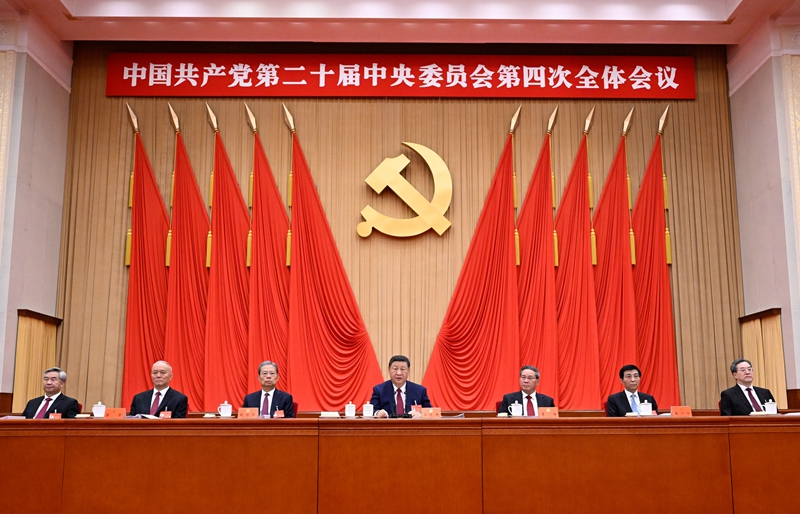
The Fourth Plenary Session of the 20th Central Committee of the Communist Party of China (CPC), convened in Beijing from October 20 to 23, shed light on China’s 15th Five-Year Plan (2026-30), a development roadmap over the next five years.
As a crucial pillar of national governance, China’s Five-Year Plans have allowed the country to think long term, act strategically, and sustain progress across decades. This mechanism has been a key driver behind what many call the “Chinese miracle.” While this idea of strategic planning was not originally conceived in China, the country’s persistence in making the plans and remarkable success in implementing them are unparalleled. This enduring success is a defining feature of what’s often called the “China model.”
Mainstream Western economics has long argued that national-level planning is impractical, advocating instead for planning at the city or enterprise level. However, this perspective appears increasingly narrow when viewed through the lens of China’s experience.
Over the decades, China has developed a new form of planning that combines the market-driven principles of a capitalist economy with the guiding hand of government policy. This approach, in which the government’s “visible hand” complements the market’s “invisible hand,” creates a synergy that has driven immense progress.
Many Western observers have wondered how China has achieved remarkable development so quickly. The truth is, these accomplishments did not happen overnight. They are the cumulative result of one Five-Year Plan after another, each building upon the last in a continuous process of accumulation. This continuity is a key advantage of China’s long-term planning approach. China’s strategic direction has remained remarkably stable. The Five-Year Plans provide a rare form of certainty in China, in a world of increasing uncertainty.

Dynamic planning
The upcoming 15th Five-Year Plan period will coincide with a time of strategic standoff between major global powers and profound instability in the world order. In this context, dynamic planning will be more important than ever. The experience of the 14th Five-Year Plan (2021-25) has proven that even under the unprecedented shock of a global pandemic and other volatile external conditions, China can still manage to meet its high-quality development targets.
The key to maintaining resilience lies, first and foremost, in combining long-term planning with short-term flexibility. The ability to make strategic decisions at the right moment and dynamically adjusting the planning and macroeconomic control is one of the inherent strengths of China’s planning mechanism.
The Five-Year Plans’ midterm evaluation mechanism should be fully utilized to make necessary adjustment in response to changing circumstances. In the past, this adjustment mechanism was rarely activated. But in today’s era of high uncertainty, it has become clear that no plan can foresee all changes, such as the sudden onset of a global pandemic or the outbreak of geopolitical conflicts. Making the national planning more dynamic is therefore essential to mitigating future risks.
From an economic standpoint, China’s growth has already been extraordinary. The People’s Republic of China has sustained rapid growth for more than 70 years. Many believe this surge began with reform and opening up launched some four decades ago, yet even before that period, China’s average annual GDP growth exceeded 6 percent. Having maintained high-speed growth for over seven decades, the nation is entering the 15th Five-Year Plan period, during which it aims to sustain medium growth for at least another decade.
How can this be achieved? The answer lies in the institutional strengths of socialism. Historically, when other nations reached a similar stage of development, many turned outward through expansion, wars or shifting industries abroad, leading to the hollowing-out of domestic sectors. China, however, is pursuing a different path, one that leverages the advantages of its socialist system and promoting interplay between an efficient market and a well-functioning government.
Take domestic demand as an example. Market forces alone are insufficient. China’s rapid rise within the electric vehicle industry would not have been possible without the government’s firm commitment to climate policy and top-level strategic design. Addressing climate change is not just an environmental necessity, but also a major driver of economic growth.
Expanding domestic demand is a systemic endeavor that involves employment, income distribution and social welfare. One of the root causes of insufficient domestic demand lies in the fact that many low- and middle-income households have the desire to consume but lack the purchasing power. Promoting common prosperity, at its core, is about boosting their consumption capacity. Likewise, projects such as urban renewal and the redevelopment of old residential areas are not only tangible measures toward common prosperity but also powerful engines for domestic demand. Behind all these efforts stands the strategic strength of the state.

New priorities
The recent plenary session laid out 12 major priorities for China’s next stage of development. At the top of the list is “building a modernized industrial system and reinforcing the foundations of the real economy.” This signals China’s resolve to chart a new course. China has realized more clearly than ever that the real economy is the cornerstone of its development. The message is clear: The modern industrial system must be built on the foundation of the real economy, with advanced manufacturing as its core. Its manufacturing value added now accounts for roughly 30 percent of the global total.
The plenary session noted that it is essential to promote the integration of manufacturing and services. China already has powerful manufacturing capabilities, but it is equally important to promote the fusion of manufacturing and services. Rather than merely selling equipment, we must expand into providing integrated services.
Equally vital is the integration of manufacturing and the digital economy. The rapid rise of China’s digital economy rests on a solid foundation—a complete and fully integrated real economy system. This allows technologies like AI to be swiftly deployed in real-world scenarios, from smart vehicles to embodied intelligence. This serves as the foundation for China’s digital economy and the bedrock of its innovation drive. A full industrial chain gives China a unique edge in innovation, so ideas can be quickly translated into prototypes, manufactured, tested and improved, creating a virtuous cycle of “innovation-manufacturing-reinnovation.”
China is now the leading trading partner for most countries around the world, and the cornerstone of this is its real economy. Trade cannot flourish without strong manufacturing capacity to produce what the world needs.
Traditional sectors will be upgraded through new technologies to preserve their strengths; emerging industries will be scaled up to form new competitive advantages; and future industries, such as embodied intelligence, controlled nuclear fusion and quantum computing, will be strategically encouraged. Even if these frontier technologies yield no immediate payoff in the next five years, their early groundwork will prove invaluable in the decade ahead. This is long-range, evidence-based planning.
Beyond that, many of the new policy arrangements also deserve close attention. Compared with the previous plan, the 15th Five-Year-Plan will put more emphasis on innovation-driven growth, industrial profitability and the construction of a modern industrial system anchored in advanced manufacturing. This shows that China has reached a new stage of development based on the foundation laid during the 14th Five-Year Plan period. Its determination to achieve modernization remains unwavering. Despite an increasingly complex and uncertain international environment, China will continue to move steadily forward along its chosen course.
The plenary session also set a long-term goal: By 2035, China’s per-capita GDP will be on a par with that of a mid-level developed country. This suggests that China’s economy will maintain steady and medium-to-high-speed growth. As long as China maintains steady growth during the next five years, the 2035 modernization target will be well within reach.
Innovation is another highlight. The plenary session stressed a “high-level self-reliance and self-improvement in science and technology,” an upgrade from the previous wording of “self-reliance and self-improvement in science and technology.” This shift reflects a deeper ambition: to seize the strategic opportunities of a new round of technological and industrial transformation and to secure future development. This demonstrates the central role of technological innovation in driving the development in the next five years. To achieve this, the plenary session underscored the need to reinforce education, science and technology, and human resources, to ensure that innovation and the real economy advance together in an integrated way.
Another noteworthy focus is the emphasis on the people. The plenary session devoted extensive attention to improving people’s wellbeing—making solid headway promoting well-rounded personal development and common prosperity for all, promoting high-quality population development and further improving people’s living standards. The principle of “people first” runs deep in Chinese tradition. During the 15th Five-Year Plan period, this centrality will be more pronounced than ever.

Opportunities for all
China’s continued opening up presents vast market opportunities to the world. Initiatives such as the China International Import Expo are creating more pathways for global products to enter China.
In the Chinese market, businesses are exposed to the world’s most dynamic industrial transformations and cutting-edge business innovations. Losing access to the Chinese market means more than losing a massive consumer base, for it also means missing out on the chance to participate in the frontier of global industrial evolution. Many European businesses have come to realize that their models and products refined in China are globally competitive.
Two features make the Chinese market unique: the intensity of competition and the speed of evolution. In almost every field, multiple technologies and companies compete side by side, pushing innovation forward. Only by participating in the market directly can one truly grasp the pulse of industrial change. For example, several European automakers, after limited engagement during the COVID-19 pandemic, were astonished to find that China’s electric vehicle industry had leapt to an entirely new level upon their return.
China’s industrial development also provides critical support for global industrial and supply chains. As the world moves toward a more optimized allocation of resources, a global system of regional specialization is gradually emerging. China remains the country with a complete industrial system, strong manufacturing capacity, and a competitive cost-performance
advantage. Through cooperation with China, countries around the world can significantly improve their production efficiency. In the ongoing restructuring of global supply chains, China stands as a stabilizing anchor.
One of the major challenges facing the global green transition is a shortage of green capacity, both in terms of insufficient renewable energy and limited green manufacturing capability. China’s strong green manufacturing base fills this gap, making a vital contribution to the world’s shift toward smarter and more sustainable development.
Chinese innovation is injecting fresh momentum into global growth. Across Southeast Asia, the Middle East, Africa and Latin America, Chinese technologies, products, and development models are accelerating local modernization processes. The Belt and Road Initiative is empowering countries in the Global South, enhancing their endogenous development capacity.
China’s expanding foreign investments will continue to unleash untapped potential. As Minister of Commerce Wang Wentao announced recently, during the 15th Five-Year Plan period, China will broaden two-way investment cooperation, focusing not only on GDP, but also on Gross National Income (GNI), emphasizing both the “Chinese economy” and the “Chinese people’s economy” (emphasizing the economy’s focus on serving the needs of the population). As Chinese enterprises’ international competitiveness grows, they are contributing to the stability and smooth operation of global production and supply chains. The returns from these overseas assets will directly contribute to GNI growth.
Taken together, China is sending a clear message to the world: A stronger China will not export war or conflict—it will export opportunities. As it continues to pursue its own stable development, China remains committed to growing alongside the world and sharing the benefits of progress. –The Daily Mail-Beijing Review news exchange item




